Effect of hydrogen peroxide and thiourea on fluorescence and tuberization of potato (Solanum tuberosum L.)
Автор: Mani F., Bettaieb T., Zheni K., Doudech N., Hannachi C.
Журнал: Журнал стресс-физиологии и биохимии @jspb
Статья в выпуске: 3 т.8, 2012 года.
Бесплатный доступ
The aim of this study is to determine the effect of hydrogen peroxide and thiourea on potato crop (quantum yield (Fv/ Fm), chlorophyll content, tuber diameter, tuber number and total tuber yield). The concentrations of these two chemicals are hydrogen peroxide: 0, 20, 40, 60 and 80 mM, and thiourea : 0, 250, 500, 750 and 1000 mM. The experiment was conducted in the farm of Chott- Mariem Institute during three months using variety 'Spunta' and arranged in a completely randomized block with three replications. Results show that there is no significant difference in tuber diameter between treatments and among the same treatment. However, tuber yield is significantly increased by 20 % by thiourea (250 mM). Maximum total yield was obtained at this concentration (810 g/plant). In addition, application of thiourea (500 and 750 mM) results in a significantly higher number of tubers number (5.7 and 5.2 respectively). In contrast, treatment with hydrogen peroxide brings about similar tuber yields. Although, application of hydrogen peroxide at low concentration (20 mM), decreases chlorophyll content and stresses plants, application of thiourea increases chlorophyll content, and improve quantum yield especially when it is applied at 250 mM.
Hydrogen peroxide, thiourea, potato, fluorescence, tuberization
Короткий адрес: https://sciup.org/14323675
IDR: 14323675
Текст научной статьи Effect of hydrogen peroxide and thiourea on fluorescence and tuberization of potato (Solanum tuberosum L.)
Potato (Solanum tuberosum L.) is one of the seven crops considered as strategic for Tunisia. It grows on a surface area of 24 300 hectares divided into 25 000 parcels and 18 000 producers grow this crop. 78 % of these farmers have a total surface area of less than one hectare and 14 % have land under two hectares, 8% have land more than two hectares. For seasonal crops (February to May), that represent 50% of the surface area devoted to potatoes, irrigation water is the main limiting factor for production because of high water demand for these crops (4000 to 5000 m3/ ha) and little rainfall that meets only 15 to 20% of needs (GIL ,2010). So, the sustainability of this crop implies improvement of yield. This is possible by fertilizers and chemicals.
According to Rahman et al., 2003; Panah et al., 2007; Mani et al., 2011, treating tubers with chemicals such as hydrogen peroxide and thiourea is efficient to break dormancy. Nevertheless, their impact on yield is yet not established.
Thus, the present study examined the effect of these two chemicals on photosynthetic efficiency and on yield parameters, including total tuber yield, number and size of tubers of potato, variety Spunta after their application on mother tubers.
MATERIALS AND METHODS
Vegetal Material and crop management
The study is carried out in farm of High Institute of Agronomy of Chott- Mariem Institute, in 2011 (Fig.1). Potato tubers (variety Spunta) are dipped in solutions of hydrogen peroxide (0, 20, 40, 60 and 80 mM) or thiourea (0, 250, 500, 750 and 1000 mM) before planting in soil .Experimental design was completely randomized block with three replications for each treatment and each concentration. Inter row and inter plant spacing were 0.80 and 0.30 m, respectively. Data were collected from twenty one plants for each treatment and each concentration.
The irrigation water has a conductivity of 1.4 mS. cm-1 and a pH of 6.2. The chemical composition of water, expressed in meq.l-1, is as follows: Ca 2 + (7.4), K + (0.1), Na + (4.9) and Cl- (5.9). The soil is composed of clay (11.5%), silt (22.5%), sand (61%) and organic matter (1%). Its pH is of 7.6. The amounts of mineral fertilizers and organic, recommended in the area of Chott-Mariem for culture of potato (Hannachi et al., 2004; Chehaibi et al., 2008) and used in our tests, are farmyard manure (30 t.ha-1), triple super phosphate (P2O5 45% :150 kg.ha-1), and potassium sulphate (K2O 54% : 400 kg.ha-1), they were used as P and K sources respectively. Theses fertilizers are incorporated in soil before planting. One month after planting, potassium sulphate (K2O 54%: 400 kg.ha-1) and ammonium nitrate (NH4 NO3); (N 33% :100 kg.ha-1) are also incorporated.
During the culture period, from October 10 to January 26, monthly weather records set each day give minimum of 9°C and maximum of 21 ° C maxima of temperature regime.
Measured parameters
Measured parameters are chlorophyll content, quantum yield (Fv/Fm), total tuber yield, number of tubers per plant and diameter tuber. Chlorophyll content is measured in 3 leaves for each concentration of hydrogen peroxide or thiourea. It is extracted by homogenizing and boiling 1 g of fresh weight leaves in 35 ml ethanol 96%. After centrifugation (10 min at 4.000 g), the chlorophyll content is determined spectro-photometrically from the ethanolic supernatant at 654 nm, as described by Wintermans et al. (1965). Ratio Fv/Fm is measured in 3 leaves for each concentration of hydrogen peroxide or thiourea at the flowering period of potato by using a rotary system type FIM 1500.
Mean total tuber yield, number of tubers per plant and tuber diameter are also measured for 210 plants.
All data of these parameters are analyzed by variance at 5% level using SAS program.
RESULTS
Chlorophyll content
Chlorophyll content is presented in Figures 2 and 3. Leaf chlorophyll was affected by hydrogen peroxide and thiourea concentrations. In plants treated with hydrogen peroxide, there was a decline in leaf chlorophyll in plants treated with 20 mM (1.90 mg/ g FW ), compared to the control (2.90 mg/ g FW) and to plants treated with 40, 60
and 80 mM of hydrogen peroxide (2.79; 2.8 and 2.94 mg/ g FW).
However in plants treated with thiourea, leaf chlorophyll is increased with increasing thiourea concentration. In fact, leaf chlorophyll measured in plants treated with 250 mM and control plant are respectively: 2.83 and 2.71 mg/ g FW , whereas, leaf chlorophyll measured in plants treated with 500, 700 and 1000 mM are respectively : 3.40; 3.37 and 3.10 mg/ g FW.
Fv/Fm ratio
Concerning plants treated with hydrogen peroxide, results showed that the maximum photochemical efficiency (F V /F M ) values are similar for different treatments (Figure 4). They are ranged from 8.37 to 8.45. However, the lowest value of F V /F M (0.77) is obtained in plants treated by 20 mM of hydrogen peroxide. The maximum photochemical efficiency (F V /F M ) of leaves of plants treated with thiourea depends on used concentration (Figure 5). This ratio is very high (0.84 and 0.83) when plants are treated with respectively 500 and 750 mM of thiourea. However, the lowest values are obtained in plants treated with 250 and 1000 mM of thiourea (0.80 and 0.80 respectively), but they remained lower than that values observed at control plants (0.81).
Yield parameters
Total tuber yield of potato treated with hydrogen peroxide and thiourea are presented in Figures 6 and 7. It depends on the type of treatment and the applied concentration. The yield of plants treated with hydrogen peroxide (20, 40
and 60 mM) varies between 635 and 669 g/plant; it remains close to the value recorded for control plants (652 g/plant). However, the lowest yield (582 g/plant) was obtained from plants treated with 80 mM of thiourea .Thus, the application of thiourea improves total tuber yield. The yield of plants treated with 500, 750 and 1000 mM varies between 730 and 784 g/plant. However, the highest yield was recorded for plants treated with 250 mM of thiourea, it equals to 810 g/plant. Whereas, the lowest yield is obtained in control plants (675 g /plant).
Average number of tubers per plant is presented in Figures 8 and 9. In plants treated with hydrogen peroxide, the number of tubers per plant did not significantly vary, it is close to 4. Nevertheless, in plants treated with thiourea, the number of tubers per plant increased significantly in plants treated with 250 and 500 mM, in this case it is equal to 5.6 and 5.2 respectively. It is higher than the values recorded for the control plants (4.1 tubers / plant). For the remaining plants, the number of tubers per plant is about 4.3 tubers / plant.
Thus, it seems that the application of hydrogen peroxide does not affect the number of tubers per plant. However, the application of thiourea at concentrations 250 and 500 mM increases the number of tubers per plant by 40 and 30% respectively.
Average diameter of tubers is presented in Figures 10 and 11. Indeed, whatever the treatment and the concentration applied, the average diameter of the tubers is about 6 cm.
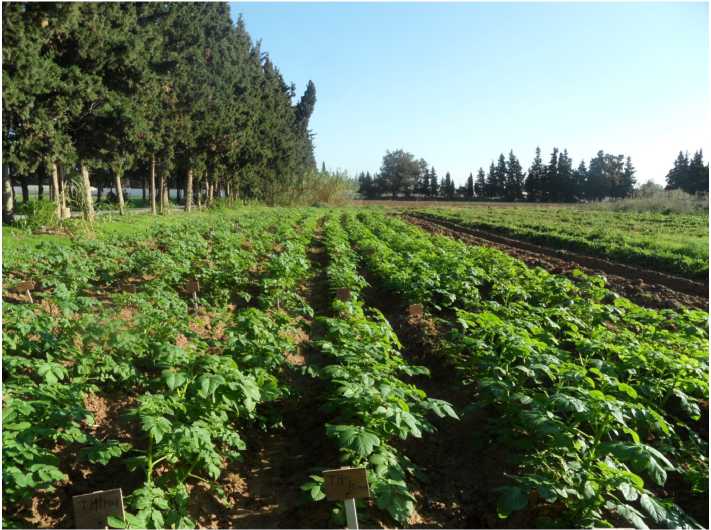
Figure 1. Culture of potato, var. Spunta, in farm of the ISA Chott Mariem, Tunisia.
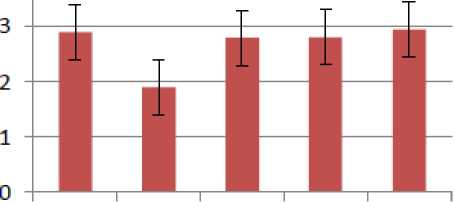
О 20 40 60 80
Hydrogen peroxide (mM)
Figure 2. Effect of hydrogen peroxide (20, 40, 60 and 80 mM) on chlorophyll leaf content (mg. g .-1 FW) of potato, var. Spunta.
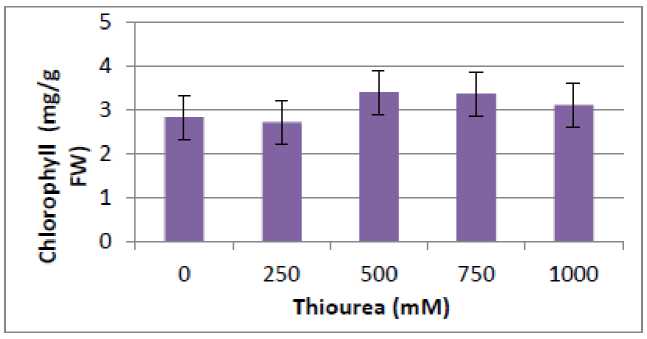
Figure 3. Effect of thiourea (250, 500, 750 and 1000 mM) on chlorophyll leaf content (mg. g .-1 FW) of potato, var. Spunta.
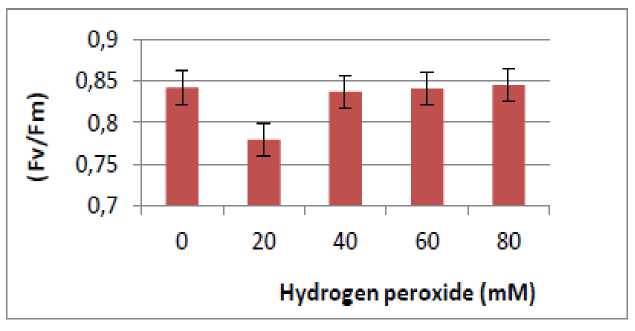
Figure 4. Effect of hydrogen peroxide (20, 40, 60 and 80 mM) on Fv/Fm ratio of potato, var. Spunta
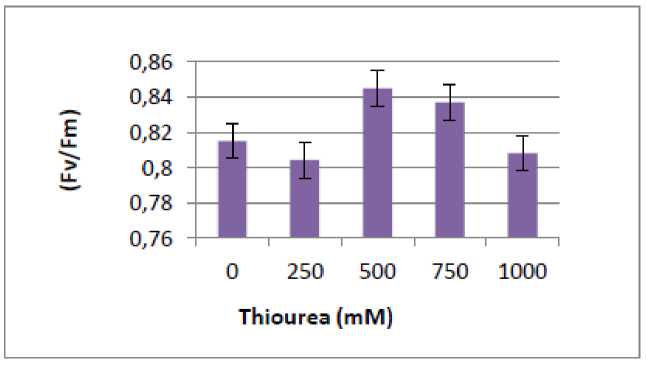
Figure 5. Effect of thiourea (250, 500, 750, 1000 mM) on Fv/Fm ratio of potato, var. Spunta.
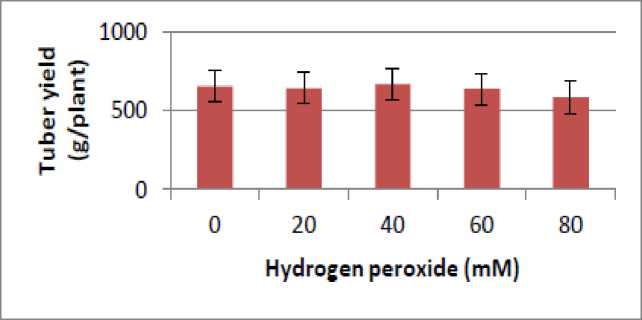
Figure 6. Effect of hydrogen peroxide (20, 40, 60 and 80 mM) on the tuber yield (g /plant) of potato, var. Spunta
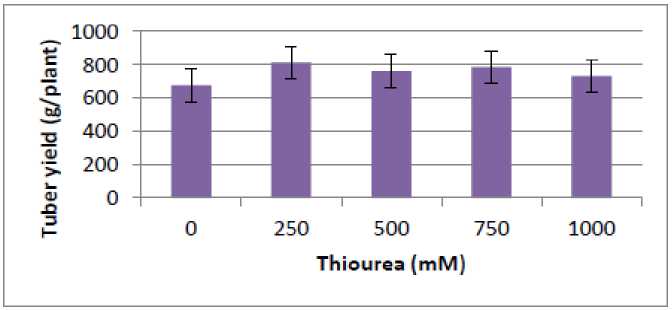
Figure 7. Effect of thiourea (250, 500, 750, 1000 mM) on the tuber yield (g /plant) of potato, var. Spunta

Hydrogen peroxide (mM)
Figure 8. Effect of hydrogen peroxide (20, 40, 60 and 80 mM) on number of tubers / plant of potato, var. Spunta

Figure 9. Effect of thiourea (250, 500, 750, 1000 mM) on number of tubers /plant of potato, var. Spunta
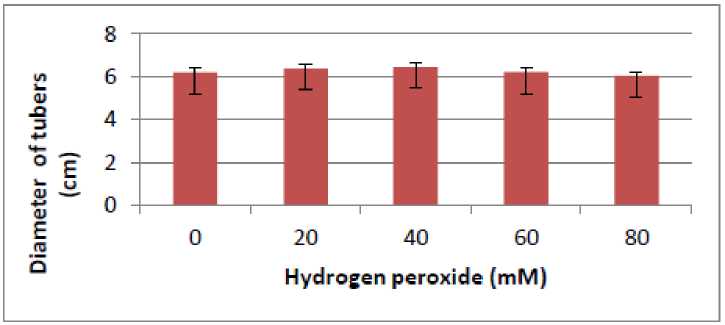
Figure 10. Effect of hydrogen peroxide (20, 40, 60 and 80 mM) on diameter of potato tubers, var. Spunta.

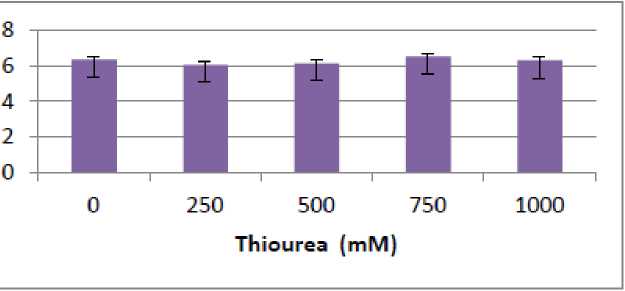
Figure 11. Effect of thiourea (250, 500, 750, 1000 mM) on diameter of potato tubers, var. Spunta.
DISCUSSION
The decrease of chlorophyll content in potatoes’ leaves treated with 20 mM of hydrogen peroxide is due to a decrease of photosynthetic activity, according to results obtained by Bettaieb et al . (2008) in gladioulous leaves and by Mehouachi (1993) in potato leaves; which shows that reduction of the content of leaf chlorophyll is associated with a decrease of photosynthetic assimilation.
Moreover, according to Hakams et al. (2000), in chlorophyll a healthy cell and under favorable conditions of growth, new molecules of chlorophylls are synthesized as others are degraded. In stressful situation, this balance is disturbed and the chlorophylls are destroyed more rapidly than they are developed.
So it’s evident that application of hydrogen peroxide and thiourea on tuber mother affects leaf chlorophyll content and photosynthetic assimilation. In addition, application of hydrogen peroxide, at low concentrations (20 mM), decreases chlorophyll content and stresses plants. Whereas, application of thiourea increases chlorophyll content and improves photosynthetic assimilation especially when it is applied at 250 mM.
The maximum photochemical efficiency or quantum yield (FV/FM) can be used to estimate the photosystem II (PSII) operational efficiency. It indicates the capacity of absorption of excitation energy by leaves, and it is usually decreasing thereafter as a consequence of leaf senescence and decrease of photosynthetic assimilation (Barbagallo et al., 2003). So, the reduced value of this ratio (Fv/Fm) measured in plants treated with hydrogen peroxide (20 mM) and thiourea (250 and 1000 mM) is related to damages on photosynthetic apparatus (Baker et Rosenqvist, 2004; Guo et al., 2006).
Otherwise in control conditions, this ratio (Fv/Fm) is generally around 0.8, and it decreases in stressful situations (Krause et Weis, 1991; Bettaieb et al., 2008). However, high values of this ratio characterize non-stressed leaves, indicates that potato plants treated with thiourea (500 and 750 mM) are highly adapted to this chemical (Barbagallo et al. , 2003; Cassana et al., 1010).
Concerning yield parameters (tuber yield, number of tubers / plant and tuber diameter), the results presented showed that the application of hydrogen peroxidedoes not improve tuber yield. On the contrary, if it is applied to high doses (80 mM), it decreases yield by 10%. These results agree with those of Al-Mughrabi (2007) which showed that the efficiency of hydrogen peroxide on yield of potato depends on the concentration applied.
Otherwise, the application of thiourea improves tuber yield, especially if it’s applied to low concentrations (250 mM). These results show that using thiourea increases tuber yield especially when it is applied at 250 mM. At this concentration, plants produced 20% higher tuber yield than control plants. It’s also increases significantly number of tubers per plant. So it seems that increasing the number of tubers is a decisive criteria for increasing the yield of potato. These results are also consistent with the previous findings (Tekalign and Hammes 2005; Germchi et al., 2011). In addition, whatever the treatment and the concentration applied, the average diameter of the tubers is about 6 cm. Consequently, treatments do not affect the average tuber diameter which seems to be a specific genetic character of the variety.
CONCLUSION
Total tuber yield, number of tubers per plant, leaf chlorophyll and quantum yield (Fv/Fm) of potato were influenced by the application of hydrogen peroxide or thiourea on mother tubers. In fact, application of hydrogen peroxide, at low concentration (20 mM), decreases chlorophyll content and stresses plants. Whereas, application of thiourea increases chlorophyll content, and improves photosynthetic assimilation especially when it is applied at 250 mM. Moreover, when compared to control, it is found that maximum yield is obtained when 250 mM of thiourea was applied on tuber mother. In this case, plants produced 20% higher tuber yield than control.
Список литературы Effect of hydrogen peroxide and thiourea on fluorescence and tuberization of potato (Solanum tuberosum L.)
- Al-Mughrabi K. 2007. Effect of Treatment of Potatoes in Storage and Pre-Planting with Hydrogen Peroxide (H2O2) on Emergence and Yield. Journal of Plant Sciences, 2: 613-618.
- Baker N.and Rosenqvist P., 2004. Applications of chlorophyll fluorescence can improve crop production strategies: an examination of future possibilities. J. Exp. Bot. 55: 1607-162.
- Barbagallo R., Oxborough K., Pallett K. and Baker N. 2003. Rapid, non invasive screening for perturbations of metabolism and plant growth using chlorophyll fluorescence imaging. Plant Physiol. 132: 485-493.
- Bettaieb T., Denden M. and Mhamdi M., 2008. Régénération in vitro et caractérisation physiologique de variants somaclonaux de glaïeul (Gladiolus grandiflorus Hort.) tolérants aux basses températures Tropicultura, 26 (1), 10-16.
- Cassana F., Falqueto A., Braga E.,; Peters A.and Bacarin M. 2010. Chlorophyll a fluorescence of sweet potato plants cultivated in vitro and during ex vitro acclimatization. Braz. J. Plant Physiol., 22(3): 167-170.
- Chehaibi S., Hannachi C., Pieters J. and Verschoore R. 2008. Impactes de la vitesse d'avancement du tracteur sur la structure du sol et le rendement d'une culture de pomme de terre. Tropicultura, 26(3), 195-199.
- Germchi S., Benam M., Panah H., Yarnia M., and A. Faramarzi A. 2010. Effect of Thiourea on dormancy breaking and performance of Agria minitubers in green house and laboratory. Journal of New Agricultural Science. 18 (6): 65-72.
- Germchi S., Behroozi F., and Badri S. 2011. Effect of Thiourea on Dormancy Breaking and Yield of Potato (Solanum Tuberosum L.) Minitubers Marfona cv. in Greenhouse. International Conference on Environmental and Agriculture Engineering. IPCBEE, 15:19-24
- GIL. 2010. Multiplication des semences de pomme de terre.1. Le projet national de production de semences de pomme de terre http://www.gil/>.
- Guo Y., Guo D., Zhou H., Hu M. and Shen Y. 2006. Photoinhibition and xanthophylls cycle activity in bayberry (Myrica rubra) leaves induced by high irradiance. Photosynthetica 44: 439-446.
- Hakam N.S., Khanizadeh J.R., De Ell and Richter C. 2000. Accessing chilling in roses using chlorophyll fluorescence. Hort Science, 35(2), 184-186.
- Hannachi C., Debergh P., Zid E., Messai A. and Mehouachi T. 2004. Tubérisation sous stress salin de vitroplants de pomme de terre (Solanum tuberosum L.) Biotechnol. Agron. Soc. Environ. 8(1), 9-13.
- Krause G.H., Weis E. 1991. Chlorophyll fluorescence and photosynthesis: the basics. Ann. Rev. Plant Physiol. Plant Mol. Biol. 42, 313-349.
- Mani F., Bettaieb T., Zheni K., Mhamdi M. and Hannachi C. 2011. Effets du peroxyde d'hydrogène et de la thiourée sur la levée de la dormance de microtubercules de pomme de terre (Solanum tuberosum L.). XXI èmes Journées Nationales de Biologie de la SSNT « Biologie: de la Molécule à l'Ecosystème» Société des Sciences Naturelles de Tunisie 17 -20 Décembre 2011, Hammamet, Tunisie.
- Mehouachi T. 1993. Evaluation de la croissance et de l'activité écophysiologique de la pomme de terre en relation avec le stress nutritif. Thèse de Doctorat. Faculté des Sciences Agronomiques de Gand, Belgique. 204 p.
- Panah D., Shahryari R., Shamel A., and Fathi. L. 2007. Effect of thiourea and GA on Agria's mini tuber dormancy breaking. Proceeding of 5th Iranian Horticultural science research Center. Shiraz University, 1-4 sep.Shiraz, Iran. p 100.
- Rehman F., Lee S., Khabir A., Joung H., and Yada R. 2003. Evaluation of various chemicals on dormancy breaking and subsequent effects on growth and yield in potato micro tubers under greenhouse conditions. Acta Horticulturae. 619: 375-381.
- Tekalign T. and Hammes P. 2005. Growth and productivity of potato as influenced by cultivar and reproductive growth. II. Growth analysis, tuber yield and quality. Scientia Hort. 105: 29-44.
- Wintermans J. and De Mots A. 1965. Spectrophotometric characteristics of chlorophylls a and b and their photosynthesis in ethanol. Biochem. Biophys. Acta, 109, 448-453.


